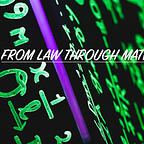From Law to STEM: A lawyer’s journey from ground zero (part 2)
This is a series about a lawyer navigating her way through math / maths / mathematics / quantitative analysis.
One of the great things about being a lawyer is that you learn to think critically about an argument. Algebra is no different, in that it forces you to think logically — balancing all of the variables or factors. If you are considering being an attorney, you will learn a lot about the rules of our government.
“I came to law school because I don’t do math! Ha!”
However, what law school does not teach you is how to count (a common refrain in law school was something along the lines of “I came to law school because I don’t do math! Ha!”) If many more potential law students learned to count, they likely would not be “spending time struggling in an anemic industry” wasting their talents (See: https://medium.com/@morrissinger/leaving-law-reflecting-on-a-year-in-my-tech-career-f82d9b15c33e). With a little bit of maths and public data from the U.S. BLS, “anemic industry” is defined in numbers. You can contact me for details.
Today, we are going to discuss the following topics using the lawyer method of critical thinking:
* INVERSE OPERATIONS
* SOLVE AN EQUATION
* SOLVE AN EQUATION USING DIVISION
* SOLVE AN EQUATION USING MULTIPLICATION
Think of these topics as mental tools to solve math problems.
INVERSE OPERATIONS:
Inverse operations are opposite operations of addition, subtraction, multiplication, division (+ — * ÷). So…
Operation Inverse (opposite)
+ -
* ÷
SOLVE AN EQUATION
To solve an equation, you need to use the inverse (opposite) operation of those listed.
SOLVE AN EQUATION USING DIVISION
- Issue: How do we use division to ensure the variable (literal factor / letter) is the same as the number on the other side of the equal sign?
- Rules: Get the variable alone. Divide both sides in the equation by the same number (except 0). Divide the side with the variable and the number on the other side of the equation.
- Application:
* 11 = 33w
* 11 ÷ 33 = 33w ÷ 33
* 11/33 = w
* 1/3 = w
- Conclusion:
* w = 1/3
* Validate / Check:
* 11 ≟ 33(1/3)
* 11 = 11 * Validated because 1/3 of 33 is 11.
- Notes / Resources:
* Dividing with decimal / percents divisors: Multiply the top and bottom by 10, 100, 1000, etc. For more info, see: https://www.wikihow.com/Divide-a-Whole-Number-by-a-Decimal
* Dividing with fraction / integral divisors: Flip the fraction. Second, multiply across the top. Third, multiply across the bottom.
* (2/3)w = 8
* w = 8 ÷ (2/3)
* w = (8/1) ÷ (2/3)
* w = (8/1) ÷ (2/3)
* w = (8/1) * (3/2)
* w = (24/2)
* w = 12
* When like terms are on one side: Combine the like terms, then solve the equation.
* 60 = 7x — x
* 60 = 6x
* x = 10
* Validate / Check:
* 60 = 7x — x
* 60 ≟ 7(10) — (10)
* 60 ≟ 70–10
* 60 = 60
SOLVE AN EQUATION USING MULTIPLICATION
- Issue: How do we use multiplication to ensure the variable (literal factor / letter) is the same as the number on the other side of the equal sign?
- Rules: Get the variable alone. Multiply both sides in the equation by the same number. Multiply the side with the variable and the number on the other side of the equation.
- Application:
* x/24 = 4
* x = 4(24)
* x = 96
- Conclusion:
* x = 96
* Validate / Check:
* (96)/24 ≟ 4
* 4 = 4
* Validated because 96 divided by 24 is 4.
